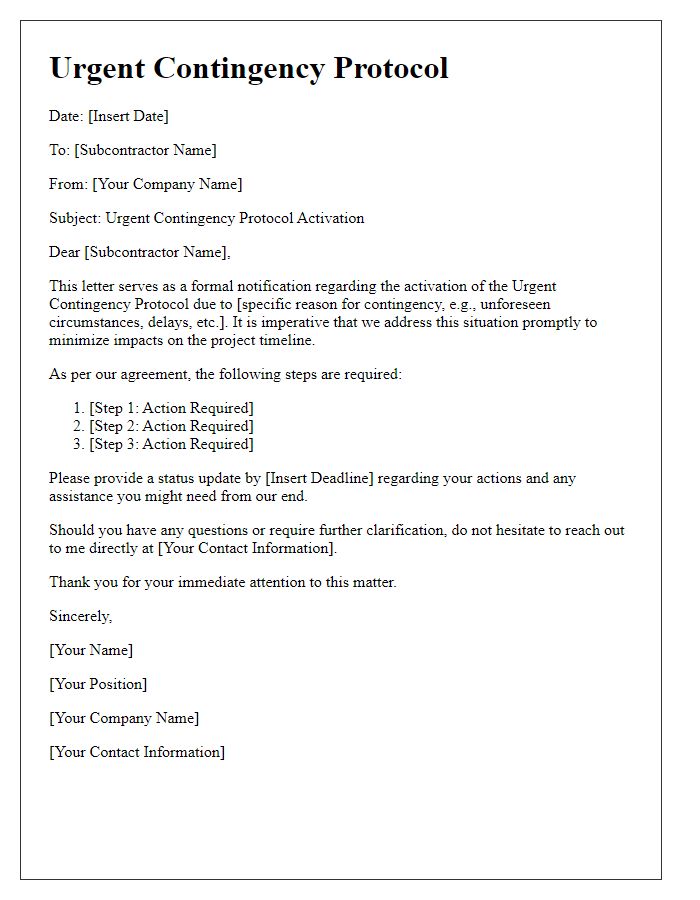When unexpected events strike, having a clear communication plan with your subcontractors is essential for maintaining a smooth operation. This letter template serves as a guide for informing your subcontractors about emergency procedures, ensuring everyone knows their roles and responsibilities during a crisis. By outlining the necessary steps and contact information, you create a sense of preparedness that can make all the difference. So, let's dive in and explore how you can effectively communicate these critical procedures!

Emergency Contact Information
In construction projects, having a clear emergency contact information protocol is crucial for maintaining safety and efficiency. Each subcontractor must provide detailed emergency contact information, including names, roles, phone numbers, and alternate contact methods. Emergency contacts should be accessible 24/7 to handle urgent issues like accidents, equipment failures, or severe weather conditions. This information should be readily available on job site notice boards and shared digitally through project management tools. Additionally, ensuring that all subcontractor teams receive training on emergency procedures fosters a culture of safety and preparedness, minimizing risks during high-pressure situations.
Detailed Emergency Procedures
In construction environments, effective emergency procedures are critical to ensuring the safety of all personnel on-site. The Emergency Action Plan (EAP) outlines necessary steps for various potential emergencies, such as fires, medical incidents, or severe weather. In cases of fire, personnel should locate fire extinguishers (located near building exits) and execute a safe evacuation plan. For medical emergencies, the presence of trained first aid responders (designated in advance) is crucial; they must have access to medical kits containing essential supplies like bandages, antiseptics, and defibrillators. Additionally, severe weather protocols must be established, ensuring that individuals seek shelter in identified safe zones (like basements or specially designated shelters). Regular drills, conducted quarterly, will reinforce these procedures, ensuring readiness and familiarization amongst all subcontractors and workers. All employees must receive training and orientations regarding these procedures, emphasizing the importance of immediate communication with site supervisors during emergencies.
Roles and Responsibilities
In emergency situations, the roles and responsibilities outlined in the subcontractor emergency procedure are crucial for effective response and management. Each subcontractor must appoint a designated emergency coordinator who will oversee operations and communications during crises, ensuring compliance with safety regulations and industry standards. Subcontractors must also establish clear lines of communication, including notifying the primary contractor and relevant emergency services, such as local fire departments or medical responders. Furthermore, designated team members should be trained in first aid and safety procedures, with regular drills conducted to ensure preparedness. Documentation of incidents, including detailed reports and timelines, remains essential for accountability and future risk mitigation strategies. Adherence to these procedures not only protects personnel but also secures project integrity and compliance with local safety regulations.
Communication Channels
Effective communication channels are essential for managing emergencies in subcontractor operations, particularly in hazardous settings such as construction sites or industrial facilities. In these environments, designated communication methods must be established, including dedicated emergency hotlines like 911 for immediate medical assistance (providing critical response times), two-way radios for real-time coordination among on-site personnel, and email alerts for disseminating important updates quickly. Furthermore, regular training on these channels ensures that all subcontractor employees (up to 50 in large projects) understand standard operating procedures during emergencies, allowing for seamless information flow. Additionally, an emergency contact list should be maintained, including key personnel (such as site managers and safety officers) alongside their phone numbers and roles, ensuring that communication remains streamlined and effective during any crisis.
Safety Protocols and Training
Effective communication of safety protocols and training procedures is essential in ensuring a safe working environment for subcontractors during emergencies. Emergency procedures should be clearly outlined, detailing steps to take when incidents arise, such as natural disasters like earthquakes (measuring 5.0 or higher on the Richter scale) or workplace accidents. Training programs must include specific safety drills, such as fire evacuation routes in large facilities like chemical plants or construction sites, emphasizing the importance of understanding escape plans and muster points. Regular training sessions, ideally conducted quarterly, can ensure that subcontractors are familiar with emergency equipment, including fire extinguishers and first-aid kits. Emergency contact information, including local authorities, medical services, and on-site safety officers, must be easily accessible to all subcontractors. This comprehensive approach fosters a culture of safety and preparedness in high-risk environments.













Comments